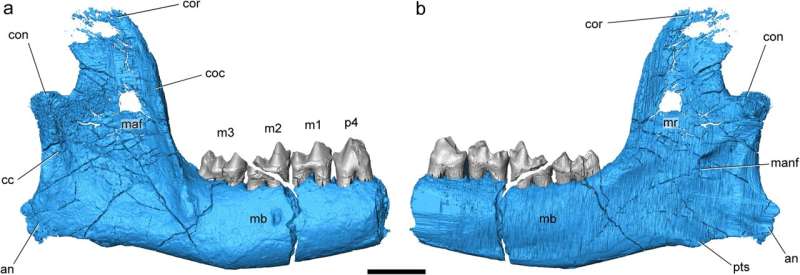May 9, 2024 report
This article has been reviewed according to Science X's editorial process and policies. Editors have highlighted the following attributes while ensuring the content's credibility:
fact-checked
peer-reviewed publication
trusted source
proofread
Likely ancestor of all modern hoofed animals identified

A team of anthropologists, paleontologists and Earth scientists from Kent State University, the City University of New York and the University of Michigan's Museum of Paleontology has for the first time identified the likely common ancestor of all modern hoofed animals.
In their study, published in the Journal of Mammalian Evolution, the group analyzed fossils found in Colorado.
In 2016, a museum volunteer discovered a fossil while exploring the Corral Bluffs, a site near Colorado Springs. Since that time, more fossils (skulls and jaws) from the same species have been found in the area. The research team studied the fossil samples and found evidence that the creature, named Militocodon lydae, is likely the ancestor of all modern hoofed animals.
During their analysis, the researchers found that the fossils had once belonged to an animal approximately the size of a modern chinchilla (or rat) weighing approximately 455 grams. They also dated the creature to approximately 65 million years ago, putting it in the Paleocene epoch, which followed the demise of the dinosaurs.
The researchers created a 3D virtual version of the ancient animal and found it belonged to the Periptychidae family—they also created diagrams of the teeth and compared them with other fossils and also modern animals.
They found that the animal's teeth represented a new evolutionary development in which grinding gave way to shearing and crushing. This finding, they suggest, indicates that M. lydae was an ungulate—perhaps the first of its family, making it the ancestor of all modern hoofed animals.
The research team also suggests that features of M. lydae appear to represent another step toward the ascendency of mammals after all of the land-dwelling dinosaurs were killed off. Its change in chewing style, they note, could help scientists better understand how life rebounded after the cataclysmic Chicxulub impactor killed off so many of the plants and animals on Earth.
They also note that it shows just how quickly diversification of animal life occurred after such a major Earth-changing event.
More information: Lucas N. Weaver et al, Skull of a new periptychid mammal from the lower Paleocene Denver Formation of Colorado (Corral Bluffs, El Paso County), Journal of Mammalian Evolution (2024). DOI: 10.1007/s10914-024-09716-5
Journal information: Journal of Mammalian Evolution
© 2024 Science X Network





















